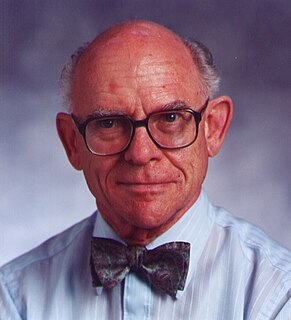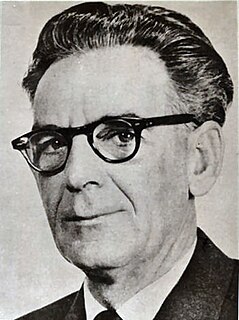Related Research Articles
Craig Jon Hawker is an Australian-born chemist. His research has focused on the interface between organic and polymer chemistry, with emphasis on the design, synthesis, and application of well-defined macromolecular structures in biotechnology, microelectronics, and surface science. Hawker holds more than 45 U.S. patents, and he has co-authored over 300 papers in the areas of nanotechnology, materials science, and chemistry. He was listed as one of the top 100 most cited chemists worldwide over the decade 1992–2002, and again in 2000–2010.

Frank Albert Cotton FRS was an American chemist. He was the W.T. Doherty-Welch Foundation Chair and Distinguished Professor of Chemistry at Texas A&M University. He authored over 1600 scientific articles. Cotton was recognized for his research on the chemistry of the transition metals.
Tobin Jay Marks is the Vladimir N. Ipatieff Professor of Catalytic Chemistry, Professor of Material Science and Engineering, Professor of Chemical and Biological Engineering, and Professor of Applied Physics at Northwestern University in Evanston, Illinois. Among the themes of his research are synthetic organo-f-element and early-transition metal organometallic chemistry, polymer chemistry, materials chemistry, homogeneous and heterogeneous catalysis, molecule-based photonic materials, superconductivity, metal-organic chemical vapor deposition, and biological aspects of transition metal chemistry.
Sir Ronald Sydney Nyholm was an Australian chemist who was a leading figure in inorganic chemistry in the 1950s and 1960s.
John Stuart Anderson FRS, FAA, was a British and Australian scientist who was Professor of Chemistry at the University of Melbourne and Professor of Inorganic Chemistry at the University of Oxford.
Christopher David Garner FRSC FRS is a retired British chemist, whose research work was in the growing field of Biological Inorganic Chemistry. His research primarily focussed on the role of transition metal elements in biological processes, for which he published over 400 original papers and reviews on the topic. His specific interests lie in the roles of Molybdenum and Tungsten as the metal centres in various enzyme cofactors based on the molybdopterin molecule.

Francis Patrick John Dwyer FAA was Professor of Chemistry, Australian National University, Canberra. He was one of the most distinguished scientists Australia has produced. At the time of his death in 1962 he was widely recognised as a leading authority in inorganic chemistry, and had laid the foundation in Australia for a new field of research bridging science and medicine—biological inorganic chemistry. His influence as a teacher and as a researcher was widespread.

Omar M. Yaghi is the James and Neeltje Tretter Chair Professor of Chemistry at the University of California, Berkeley, and an elected member of the US National Academy of Sciences.
Richard John Puddephatt, was born 1943 in Aylesbury, England. He is a Distinguished University Professor in the department of chemistry at the University of Western Ontario, in London, Ontario, Canada. Richard is a former holder of a Canada research chair in material synthesis. He has been studying the fundamental chemistry of gold and other precious metals in the development of new materials for potential applications in health care and electronics. Dr. Puddephatt's research interests involve organometallic chemistry related to catalysis and materials science, and he is considered a world expert on platinum and gold chemistry. He has authored two books: The Chemistry of Gold and The Periodic Table of Elements.
Jing Li is a professor at Rutgers University. She and her team are engaged in solid state, inorganic and inorganic-organic hybrid materials research. Her current research focuses on designing and developing new materials for applications in the field of renewable and sustainable energy.

Sir Anthony Kevin Cheetham is a British materials scientist. From 2012 to 2017 he was Vice-President and Treasurer of the Royal Society.
Harry R. Allcock is Evan Pugh Professor of chemistry at Pennsylvania State University.
Richard B. Kaner is an American synthetic inorganic chemist. He is a Distinguished Professor and the Dr. Myung Ki Hong Endowed Chair in Materials Innovation at the University of California, Los Angeles, where he holds a joint appointment in the Department of Chemistry and Biochemistry and the Department of Material Science and Engineering. Kaner conducts research on conductive polymers (polyaniline), superhard materials and carbon compounds, such as fullerenes and graphene.

Andrew Bruce Holmes is an Australian and British senior research chemist and professor at the Bio21 Institute, Melbourne, Australia, and the past President of the Australian Academy of Science. His research interests lie in the synthesis of biologically-active natural products and optoelectronic polymers.
Samaresh Mitra is an Indian bioinorganic chemist and an INSA Senior Scientist at the Indian Institute of Chemical Biology (IICB). He is known for his researches on inorganic paramagnetic complexes and low-symmetry transition metal complexes and is an elected fellow of the Indian National Science Academy, the National Academy of Sciences, India and the Indian Academy of Sciences. The Council of Scientific and Industrial Research, the apex agency of the Government of India for scientific research, awarded him the Shanti Swarup Bhatnagar Prize for Science and Technology, one of the highest Indian science awards, in 1983, for his contributions to chemical sciences.

Subramaniam Ramakrishnan is an Indian polymer chemist, a professor at the Department of Inorganic and Physical Chemistry http://ipc.iisc.ac.in/~rk/and the designer at Macromolecular Design and Synthesis Group of Indian Institute of Science. He is known for his studies on design and synthesis of controlled polymer structures and is an elected fellow of the Indian Academy of Sciences The Council of Scientific and Industrial Research, the apex agency of the Government of India for scientific research, awarded him the Shanti Swarup Bhatnagar Prize for Science and Technology, one of the highest Indian science awards, in 2005, for his contributions to chemical sciences.
Douglas Wade Stephan is Professor of Chemistry at the University of Toronto, a post he has held since 2008.

Francesco Caruso is Melbourne Laureate Professor and National Health and Medical Research Council (NHMRC) Senior Principal Research Fellow in the School of Chemical and Biomolecular Engineering at the University of Melbourne, Australia. Caruso is Deputy Director of the Australian Research Council (ARC) Centre of Excellence in Convergent Bio-Nanoscience and Technology.

Kumar Biradha is a researcher in the field of crystal engineering. He was born on 15 June 1968 in Relangi, Andhra Pradesh. He is a professor at the Department of Chemistry, Indian Institute of Technology, Kharagpur, and an Associate Editor of Crystal Growth & Design, an American Chemical Society Journal.

Deanna Michelle D'Alessandro is an Australian chemist who is a Professor and Australian Research Council Future Fellow at the University of Sydney. Her research considers fundamental aspects of electron transfer in molecular coordination complexes and in nanoporous materials, and the development of metal–organic frameworks for environmental applications including carbon dioxide capture and conversion.
References
| Scholia has a profile for Richard Robson (Q23073819). |
- ↑ "Robson, Richard - Biographical entry - Encyclopedia of Australian Science".
- ↑ Hoskins, Bernard F.; Robson, Richard (1989). "Infinite polymeric frameworks consisting of three dimensionally linked rod-like segments". Journal of the American Chemical Society. 111 (15): 5962–5964. doi:10.1021/ja00197a079.
- ↑ Wise, Donald (27 March 1998). Electrical and Optical Polymer Systems: Fundamentals: Methods, and Applications. CRC Press. p. 872. ISBN 978-0-8247-0118-5.
- ↑ Stuart R. Batten; Suzanne M. Neville; David R. Turner (2009). Coordination Polymers: Design, Analysis and Application. Royal Society of Chemistry. p. 19. ISBN 978-0-85404-837-3.
- ↑ "The Burrows Award: Inorganic Division of the Royal Australian Chemical Institute (RACI)".
- ↑ "Outstanding Academy Fellows elected to Royal Society". Australian Academy of Science. Retrieved 10 May 2022.